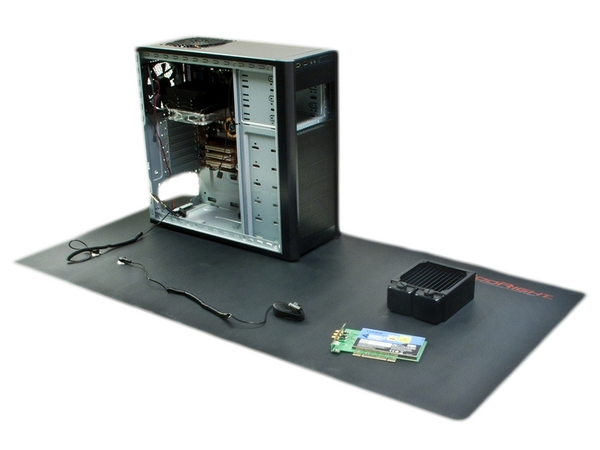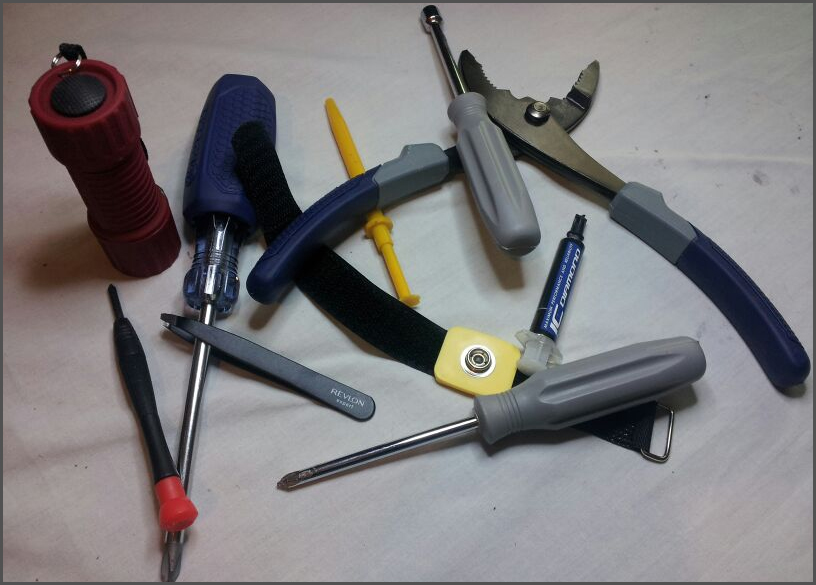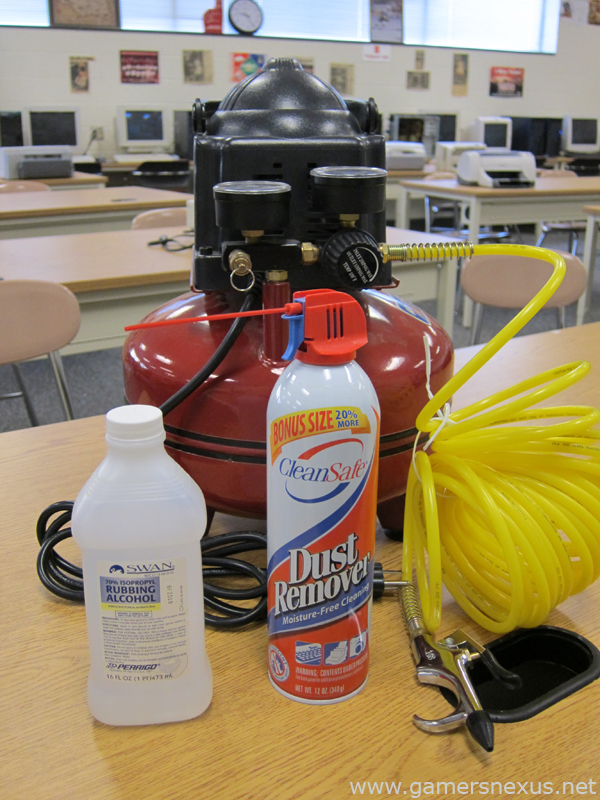Proper preventative maintenance can extend the life of your computer by many years, as we've written about previously, but getting to a point of maintaining requires, of course, the completion of an actual build. Between beginners, intermediate builders, and enthusiasts, there's an abundance of cool hardware utilities for system building, testing, and benchmarking. With anything from a screwdriver to 'anklet' ESD straps to open-air test benches, there are many applications of the ever-increasing selection of hardware assembly tools out there.

In this guide, we'll look at the Must-Have PC building tool kits, testers, and benches that aim to make your life as a system builder easier.
Before jumping into any system assembly process, we always point builders toward our 'Common PC Building Mistakes' guide, which attempts to help eliminate some of the sillier mistakes that can occur when building a gaming rig. With that note out of the way, let's jump into the must-have tools!
(Quick additional note: If you run across any questions at all during this post, leave a comment below or hit up our forums -- we try to answer every question we get).
Basic Stuff
Anti-Static Utilities
The plain yellow-and-black ESD wrist strap isn't the only one on the market (though it is great for most builds). ESD work mats are also available, adding a bit of redundancy and protection for when parts need to be set aside for use later. Using the 'pink foam' from a motherboard box will work well enough, to be sure, but an ESD mat can be nice for when more room is required.

You can find them pretty easily, but I have personally used this one with no complaints to speak of. There are plenty of others - check your favorite shopping website for "ESD Mat" - they vary in size and price.
For those who like to play doctor, ESD gloves are also available at cheap prices, although I do not prefer them since they tend to be a bit more disposable.
Things to look for: Many of the best ESD mats come with clip-in locations for ESD wrist straps, ensuring that you're actually grounded. In terms of ESD wrist straps themselves, they're pretty standard. A lot of the 'wireless' ones are bogus, so be careful and do your research. There are wireless ankle straps that I've used in a professional /enterprise environment, but I've never seen them for sale on the consumer level.
Tool Kits
A screwdriver and a hammer. That's all anyone's ever needed for a system build. Look it up on Wikipedia, it's true. Go ahead, I'll wait.
Well, I suppose it's not true. There are thousands of tool kits for system builders out there, so it's only fair that we look through a few of them. A screwdriver will get most systems to completion, a hammer will ensure destroyed evidence -- err, I mean, hard drives -- and thumb-screws will do the rest. It is useful to have claw-like grabbers for grabbing things in tight corners, pliers for freeing stripped screws, flashlights - since system building is always done in low-light, it seems, and various sizes of each tool for reaching under those massive CPU heatsinks.

Belkin makes a lot of the cheaper starter kits, as we have seen with their previously-mentioned yellow ESD strap, but Rosewill (makers of the Thor V2 and R5 gaming cases) has a number of generic toolkits out there, too.
Extra screws are always recommended for any stockpiling system builder. The damn things are so easy to lose... "I'll put all the rounded/small ones here, and all the corkscrewy ones there, and... wait, damn it, which pile is the roundy-square ones?" That's where the extras come in. There are many options on many shopping sites for screws, but this generic kit of motherboard stand-offs, ATX screws, and mounting screws will get you started. Alternatively, try this one.

Things to look for: Screwdrivers. It sounds dumb, but seriously: Get as many types of screwdrivers (within reason, and price) as possible. Fat screwdrivers - like the more expensive Cobalt ones that can be found in your typical hardware store - are perfect for removal of stripped screws. Removing stripped screws from a motherboard can be dangerous since, of course, it's not a good idea to spread metal shavings all over the case with a drill, so fat screwdrivers are good for that. Some kits come with ratcheted screwdrivers, measuring tape, and multiple bits/heads, all of which can be useful. I personally like the clawy-grabby-things for retrieving dropped screws, which can be found in cheap sets like this one.
Fancy Stuff
The aptly-named 'fancy stuff' section will contain 'fancier stuff' (clever, we know - Jonathan Coulton's Fancy Pants may have sourced inspiration) that would primarily be used for secondary testing, analysis, benchmarking, and troubleshooting; none of these items are 'required' for system building, but they may be useful for builders who find themselves wanting more (or often break things).
Power Supply Testers
Likely the most universally useful device in this section, power supply testers (albeit not 100% accurate) can give a great idea of whether a PSU is actually outputting at the voltage and wattage that it advertises. This is great in the event that you, for example, stay up all night and then manage to force your power connector into the motherboard backwards. Just an example.

Our PSU test (video below) works wonders in lieu of a dedicated device, but these gadgets give voltage readings and will provide a better overall idea of functionality.
Things to look for: Plugs for the 24-pin, 6-pin, and 8-pin power sources.
Multimeters
For even more advanced testing capabilities, Multimeters make for excellent plug/cable/mount troubleshooting. When suspicious of a particular set of pins on a device, these will read-out the current passing through and help you make a decision on whether it's faulty or normal.

This Equus 3320 is one of the prettier, more functional options out there, but searching for "multimeter," "ohmeter," or "voltmeter" will retrieve all the options.
Things to look for: Auto-ranging scales to eliminate manual dialing-in, multi-purpose devices that can be used for other electronics - not just PCs, AC/DC current readings, continuity, and ohm/voltage readings.
Cable Continuity Testers
Instead of simply trying a different cable, as is most economically-friendly, verifying cable continuity can be done with use of an intermediary tool. Trendnet, Rosewill, and others make cable testers - just make sure to read the specs before purchase, since some are rather limited in their testing ability.
Things to look for: Network cable testing, USB testing, SATA testing, etc.
Wattage Readers
It's always good to know how much power a system is consuming, and although we went over front-panel displays capable of such a task in our "souping-up your PC" article, this is a more discrete method. The Kill-A-Watt wall mounts are pretty simple: Plug it into the wall, plug your PC into it, and check for wattage consumption.
These devices do have a limited measurement of power consumption, so anything too large may blow the unit. Just RTFM beforehand (or ask below).
Things to look for: Rated power consumption/load. Rating by kilowatt/hour is a good way to calculate electricity costs, too.
Test Bench
Providing an ESD-cleared, stable area for component testing reduces overall risk of sweaty system building (and damage) when benching new components. Test benches and stations, should money permit, are some of the ultimate pieces of equipment for avid system builders; with the high rates of DOA hardware, it's always nice to test products thoroughly before mounting in a case.

Things to look for: Compatibility with all form factors - or, at least, the ones you're concerned with. Multiple shelves (ideally, one for PSUs/drives and one for the motherboard/components). Cooling "lite," but nothing serious. Just enough to keep it running. Expansion bay mounts to keep video cards in place. Enough height/length to fit the video card of choice.
Sleeving Kits
Sleeving kits, as the name might suggest, are useful for completely re-doing cable coloring and, well, sleeves. Converting cables to be all sleeved in UV-reactive white or green, for example, can be done with a sleeving kit.
Things to look for: Watch out for low-quality kits. Some materials are easy to tear, so always read over user reviews carefully.
Cleaning Tools
Ever since our Preventative PC Maintenance guide, we've seen a rise in questions about proper cleaning tools and maintenance requirements for high-end systems. None of these are absolute requirements, but it is inadvisable to use any cleaning brushes or vacuums that are not anti-static, since those could potentially damage expensive components. Only use anti-static tools for this.
Air Compressors for PCs
Air compressors will eliminate the use for those crappy cans of air -- anyone who goes through one or more cans a year may want to consider the investment, other than that, the cans will do fine for the average user.
Air compressors gain where canned air loses, though: Upside-down and angled cleaning. Blasting 60PSI (or higher) through a case will uproot dust from all its crevices, but doing so upside-down is way cooler. A favorite compressor is Metro's ED500 DataVac (specifically made for electronics cleaning) for its affordability and angled capabilities. Standard shop compressors will also work, just don't overdo the PSI.
Some cheaper compressors can accumulate water from condensation in colder environments, so always blast out a bit of air elsewhere before using it on your system.
Things to look for: Nozzle attachment options, adjustable PSI, electronics-grade.
Canned Air
If a $60 investment is too much for a small job, generic anti-static canned air/gas from your local office store will do the same job at around 1/6 the price. Canned air does have limited blast life, though, so it is typically only good in 2-minute bursts. Similarly, cans have a tendency to spray frozen liquid into a system when turned upside-down.
Things to look for: When the can starts to feel ultra-cold, stop using it.
Alcohol - The "Don't Drink This or You'll Go Blind" Kind
Standard convenience-store-bought rubbing alcohol (90% or higher preferred; 70% acceptable) works wonders when combined with Q-Tips for thermal compound removal. Always clean off a CPU before mounting a new heatsink (or vice versa) -- using Q-Tips and rubbing alcohol is a money-friendly way of doing this.
Things to look for: Watch out for residual cotton. Let the CPU dry completely before applying new thermalpaste to prevent dissolution.
PC-Rated Cleaning Drops
If rubbing alcohol is too much of a pauper's liquid for your usage, liquids that are dedicated to thermal compound removal can also be purchased at relatively-affordable prices, although they're less versatile in everyday life.
Phobya makes some of the more accessible stuff, but searching for "CPU cleaning kit" should do the job.
Things to look for: Don't put it in your eyes.
Make it Shiny - Heatsink Polish and Cleaner
Keeping those damn multi-finned heatsinks -- you know, the ones that cut fat hands to ribbons upon installation -- clean and shiny is tough. Dust accumulation and any oxidization (however rare) can tarnish the metal. This doesn't have much impact from a performance standpoint, but you won't win any fancy pants competitions with it.
Thermalright makes a "Metal Bright" compound that can be safely applied to heatsinks, making them shiny-clean and removing oxidization from any oxidized contacts.
Things to look for: Non-volatile and non-toxic materials or liquids.
Conclusion & Resources
Some favorite places for random shopping and tools browsing, aside from any local stores that you may have, can be found in this alphabetical list:
- Amazon: Big, lots of stuff. You know the rest.
- MicroCenter: Some of the best electronics prices we've ever seen.
- NCIX: Great shipping options and competitive with...
- Newegg: Arguably the biggest name in electronics retail.
- TigerDirect: Fierce competition with NCIX and Newegg, albeit an obnoxious interface.
- Xoxide: A personal favorite for more serious modding tools that you may not find elsewhere.
- XPCGear: Similar to Xoxide, they provide many modding options.
For more guides from us on similar topics, look around in these places:
- PC Preventative Maintenance
- Souping-up Your PC
- Common PC Building Mistakes
- Cutting Costs in PC Building
- GN's Famous PC Builds (Tastes like chicken)
That's all for now. If we missed something or if you have suggestions, add 'em below and we'll get the guide updated. Any questions should also be asked below in the comments, but our forums serve as a fantastic outlet for in-depth questions and community.
-Steve "Lelldorianx" Burke.
